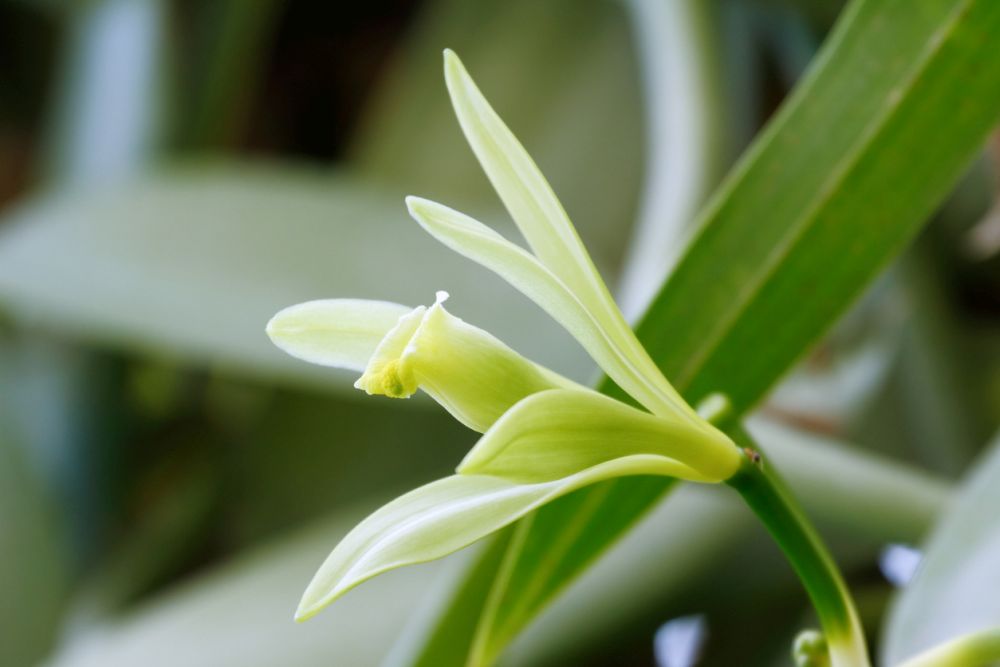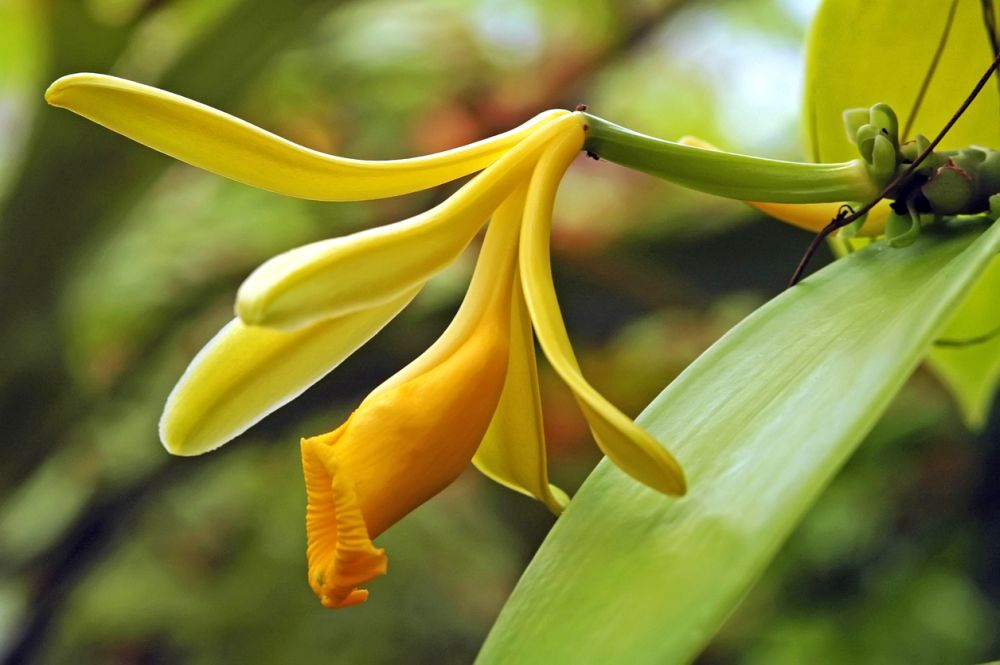Vanilla Orchid Care – How To Grow Vanilla Bean Orchids
Vanilla is a staple flavour in every kitchen. From water ice cream and chocolate to dessert recipes and beverages, vanilla makes everything not just palatable but downright delicious. And if you're wondering where this magical white substance comes from, wonder no more. Vanilla is extracted from the seed pods of the vanilla bean orchids. And while you can certainly grow the vanilla orchid in your garden, most gardeners practise that for its landscaping values rather than for its fragrant seed pods. It's not an piece of cake found to abound, though and there's a lot to consider and pay attention to. Also, if you're looking for a flowering plant, the vanilla orchid blooms can exist a real challenge. Then permit's unpack all of that.

Vanilla Orchid Nuts
Vanilla orchid (Vanilla planifolia), or vanilla bean orchid equally it'south sometimes known, has a vine-like growth and usually flowers in the late leap or early summer. The give-and-take vanilla comes from the Spanish word for small pods, "vainilla." It's a native of Mexico and likes to crawl and observe back up in other plants or trees nearby.
And that'southward where the ornamental values of these orchids come in. They have flat leaves, which are the most striking features every bit far as horticulturalists are concerned. As we mentioned, you volition discover information technology hard to become the vanilla orchids to blossom in your garden, merely the leaves are ornamental plenty in many cases. Not to mention the fashion the flexible stems wrap themselves around tree trunks and create stunning zig-zags.
As perennial creepers, the succulent stems tin can attain heights of 30 feet. Only since they crawl and wrap themselves like a vine, they unremarkably end up taking less infinite than that. The aeriform roots are another landscaping bonus. But it's actually the leaves that steal the show.
They are large and flat with bright greenish shades. Each leaf grows to up to ten inches long and almost two and a one-half inches wide. Even if your vanilla orchids blossom, they volition take at least about 3 years from the fourth dimension y'all found them to finally testify their flowers. When they finally appear, the blooms are yellow and fragrant.
The fruits of the vanilla, or its beans, are pods that turn dark as they ripen. Each pod is about 8 inches long, and they become effluvious one time they're ripe. This ripening might have anything betwixt 8 to 9 months.
Vanilla Orchid Varieties
Some of the common vanilla orchid varieties to plant in your garden include the following.
- W Indian Vanilla (Vanilla pompona): 1 of the almost pop vanilla orchid varieties that people mainly abound for the vanilla extracts. The odor and fragrance of this type are both quite strong. Simply you can grow it for its ornamental values, especially the big and sleeky leaves.
- Tahitian Vanilla (Vanilla tahitensis): Originates from Tahiti; that'southward why information technology got that name. The vanilla you go out of this variety has a different taste and season than the other types. It also produces smaller pods, and its leaves are elliptic in shape. When it flowers, the yellowish-light-green blooms are a bonus.
- Leafless Vanilla (Vanilla aphylla): A native of Southern asia, it's famous for its clusters of flowers that bloom in the late spring and early summer. The stems of this variety twist and co-operative out similar vines and are usually leafless and covered instead with internodes.
- Mexican Vanilla (Vanilla mexicana): The vines of this variety are unremarkably long and can reach 15 feet. It'due south a native of Cardinal America, where people have been growing it for its effluvious vanilla extracts.
How to Grow Vanilla Bean Orchids
While the vanilla bean orchid is not your typical house or garden plant, that doesn't mean you cannot grow it in your garden. Even if you have no interest in the vanilla extracts, the ornamental values of this orchid put it on the must-take list of many gardening enthusiasts. Information technology does require some work and more than care than other plants, only to take a live vanilla bean orchid growing in your garden is worth every amount of work y'all put into it.
- Pick a medium-size pot or container with plenty of drainage holes at the bottoms. Clay pots will work but fine.
- Make full the pot with a rich potting mix or fertile soil. Add together in plenty of organic cloth, shredded osmunda, and organic compost. Mix well.
- Place the pot or container most a pole or a stake since the vine needs support to climb upwards.
- If you bought the vanilla orchid plant, take it out of the pot and dig a pigsty in the soil deeper and wider than the original pot. Identify the plant in the hole and fill information technology up.
- If y'all are planting the orchid from a cut, dig a hole in the soil and identify the cutting about iv inches deep in the hole. Fill the hole with soil and pack information technology lightly.
- Water the pot until the water flows out of the drainage holes to assistance settle the found or cut in the soil.
- Keep the soil moist but not moisture.
- Information technology will take the establish annihilation between 3 to five years before it matures and produces flowers.
- One time the flowers bloom, you'll need to pollinate them yourself to produce pods.
Vanilla Edible bean Orchid Care

If patience is a virtue, the vanilla bean orchid sure needs y'all to be equally virtuous equally you possibly tin can. From the time you plant it until the blooms finally open up on the orchid, you volition demand to dedicate your time and energy to keep the found growing successfully. This includes providing adequate light, water, fertilizer and ensuring that it's both pest- and disease-gratuitous. Easier said than washed, you might say. And you lot're absolutely right. The vanilla bean orchid is not for absolute beginners who want to meet the fruits of their labor blossom in a matter of weeks rather than years.
Soil
For a constitute that stays for years before it can testify the first bloom, you demand to pay extra attention to the soil. Even if the plant is not showing a whole lot of growth in the commencement 3 years of its life, that doesn't mean that information technology doesn't need rich soil. Before y'all plant the orchid, check that the soil has high deposits of potassium and calcium. The pH should not exceed 7 by whatsoever chance. The soil needs to be light and loose. If you can't find the right potting mix, yous can add perlite and organic material to loosen the soil and improve drainage.
Water
Watering is another tricky consequence equally far as the vanilla orchids are concerned. Once more the plant takes years to grow and bear witness signs of life, and so information technology'south easy to forget to water it. But that could kill the establish since it likes the soil moist just not dry out. Avoid overwatering since moisture soil leads to root rot and fungal infections. Root rot can be difficult to detect in the early on stages of the orchid's growth. As a rule of thumb, you should wait for the soil to become dry out between irrigations.
Light
Information technology goes without saying that all climbers don't do well in the full sunday. They grow in the shade of large copse, so whatever low-cal they get is usually filtered. In your garden, you need to provide the aforementioned calorie-free conditions the vanilla orchids are used to in their natural habitat. A shaded place that keeps them from the glare of the lord's day is ideal for their growth and success. It'southward okay if they get the morn sunday for a couple of hours. Just excessive sunlight stunts the growth of these deadening-growing orchids. The lack of light also gives the same bad results. So aim for a partially shaded spot that has enough light.
Fertilizer
Whether they're flowering or not, you need to fertilize your vanilla orchid. Regular fertilizing about one time every two weeks improves the growth and speeds up the maturity and flowering of these orchids. By speeding upward, I hateful it can cutting the waiting period from 5 years downwards to 3 years before y'all see the starting time flower. Once the flowers open, you need to increase the fertilizing to in one case a week. Use a diluted dose of the regular fertilizer not to fire the roots. Agree off the fertilizer after the flowers have faded.
Pests and Diseases
Plants attract bugs and pests, that'south a given. And when the plant is equally aromatic as the vanilla orchid, you can expect a different blazon of pests than your average aphids and mealybugs. Most often, you'll find bugs scurrying effectually, such every bit vanilla bug, beetle, giant African snail, vanilla vine weevil, Achatina, and white grubs. If you catch them early on, there's a good hazard you lot can forestall an infestation. Utilise a swap soaked in alcohol to glaze the stems and leaves and impale the small bugs. As for the big ones, such as the beetles, you tin pick them upwardly and drown them in a bucket total of h2o and detergent.
As for diseases, well, you also accept a few to bargain with. The first is root rot. A common problem for many annuals and perennials. It often happens when you lot overwater the plant, or the soil is not well-drained. The problem with the vanilla orchid is that for the first couple of years, y'all won't be able to detect the symptoms of root rot since there are no leaves yet.
The other health issues you might encounter with the vanilla orchid include blackness rot, rust, anthracnose, and stem rot. Fungal infections are the main crusade of these diseases.
Source: https://www.diys.com/vanilla-orchid/
Post a Comment for "Vanilla Orchid Care – How To Grow Vanilla Bean Orchids"